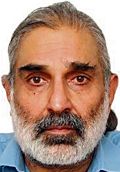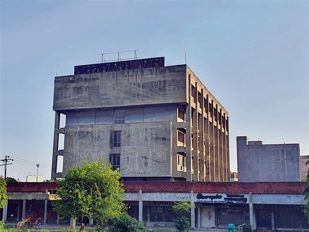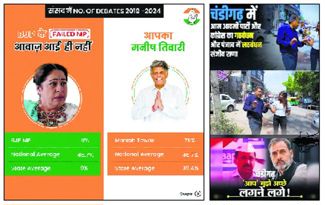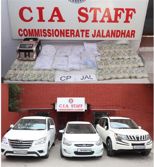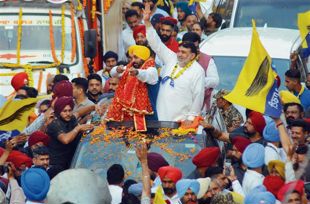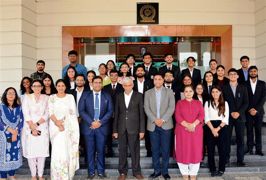
Deliberations: Chief of Defence Staff Gen Anil Chauhan (right) with Army Chief Gen Manoj Pande. The onus of validating the ITCs’ operational command and control framework is on the DMA and the CDS. PTI
Rahul Bedi
Senior Journalist
THE recent Parivartan Chintan (contemplation regarding change) related to the long-planned creation of integrated theatre commands (ITCs), presided over by the Chief of Defence Staff (CDS), Gen Anil Chauhan, was yet another instance of the military top brass examining extant proposals but expecting vastly different results.
According to the government, the day-long ‘brainstorming’ session on April 8 in New Delhi, attended by senior officers from the three services, highlighted the need to adopt a ‘de novo’ (fresh) approach towards developing operational ‘jointness’ in the armed forces. It was mentioned that these deliberations underlined the necessity of augmenting interoperability and ‘jointness’ to enhance the Indian military’s overall efficiency and war-fighting prowess.
The takeaways from the Parivartan Chintan, however, remained nebulous, except to confirm that the ITC matter remained unresolved and that the 2022 deadline declared by Gen Chauhan’s predecessor Gen Bipin Rawat for their creation was long past. Numerous ITC models had been prepared by the Department of Military Affairs (DMA), which the CDS heads, that broadly envisage fashioning three tri-service commands — one each for the country's northern and western borders and an overarching maritime or peninsular command, alongside options for ‘additional others’, but these, it now appears, are seemingly inadequate.
All three provisional ITCs had been tentatively designated their headquarters — Lucknow, Jaipur and Karwar (Karnataka). But a cross-section of veterans claim that numerous challenges persist for the DMA, pending the ITCs’ final endorsement by the Cabinet Committee on Security headed by the Prime Minister. The foremost is the issue of the ITCs’ overall operational command and control that was inherently ‘hobbled’ by hierarchical inter- and intra-service rivalries, conflicts of interest and ambitions of personnel involved in this planned revised military architecture.
By virtue of his employment charter, the CDS himself is not part of this operational equation, despite being India’s seniormost military officer. Under his terms of appointment, the CDS exercises no direct operational military command, including that over the three service chiefs. His remit, among a host of myriad responsibilities, includes enabling and augmenting jointness, prioritising materiel buys, forces’ modernisation and giving the government impartial military advice.
Recent media reports and analyses by security experts indicate that the role of the three four-star service chiefs, in a revised ITC setting, would be limited to recruiting and training manpower and logistically supporting it. This reportedly ‘miffed’ the individual chiefs and possibly the Parivartan Chintan debated a more proactive operational role for them than merely a supportive one.
Besides, in consonance with the US theatre command model, on which the Indian ITC template is largely believed to be patterned, the chain of military command flows from the President to the Secretary of Defence and onto the theatre commanders and back. The latter were overseen by another four-star officer, the Chairman of the Joint Chiefs of Staff, who, like India’s CDS, performed an advisory role to the US political leadership.
If localised, this concept, centred on US expeditionary doctrines, would incorporate ITC commanders reporting directly to the Defence Minister, who, like the US Secretary of Defence, would then be the deciding operational authority, but obviously in the Indian context with no military or battleground experience. To overcome this handicap, a former Indian Navy chief of staff had in a recent seminar suggested appointing someone with deep knowledge of military affairs with multi-party consensus as Defence Minister.
The other, more critical issue, and one that reportedly dominates discussions within the services and the DMA over delays in confirming the ITCs, is the parity in status and seniority of officers presently heading the 17 single-service geographical and functional commands. The Army and the Indian Air Force had seven such commands, and the Navy had three.
And, with these 17 commands to be eventually subsumed into three, four or even five ITCs, one immediate fallout would be the ‘placation’ of some 13-14 three-star officers in a rank-conscious environment. Overnight, these officers would be ‘dispossessed’ of not only their elevated statuses, but also of their numerous perquisites, including the use of aircraft and rotary assets.
Additionally, some 10-odd Principal Staff Officers at the respective service headquarters, three vice-chiefs of staff and the Integrated Defence Staff (IDS) head would also need to be 'adjusted' without further engendering disaffection or any loss of their sheen in the revised ITC setting. The numerous three-star heads of directorates at each of the three service headquarters would need to be similarly accommodated in this massive revamp guaranteed to radically alter the Indian armed forces’ structure. Other related measures that were believed to be delaying the ITCs’ formation included the appointment of a Vice CDS and Deputy CDS to oversee assorted ‘verticals’ in military planning, like intelligence gathering, procurements and joint training.
Presently, India has two tri-service commands — the Andaman and Nicobar Command (ANC) to safeguard India's strategic interests in the Indian Ocean Region and the Strategic Forces Command tasked with ownership of the country’s nuclear assets, deliverable by land-based mobile platforms, by air and via underwater assets. These came into being soon after the recommendations of the Group of Ministers in 2001, following the 1999 Kargil War, and were placed under the IDS with the express intent of crafting a future blueprint for ITCs, which, a section of former service chiefs claim, has been bypassed. In conclusion, the onus of validating the ITCs, especially their operational command and control framework, is on the DMA and the CDS, not on the political leadership, which green-lighted the project and now awaits its outcome.
Join Whatsapp Channel of The Tribune for latest updates.






